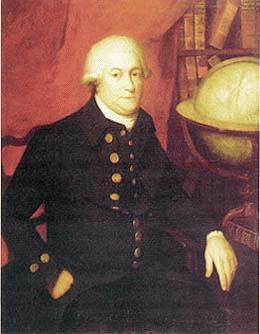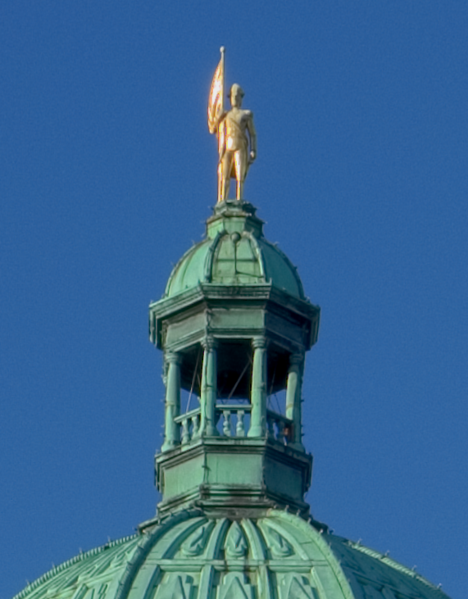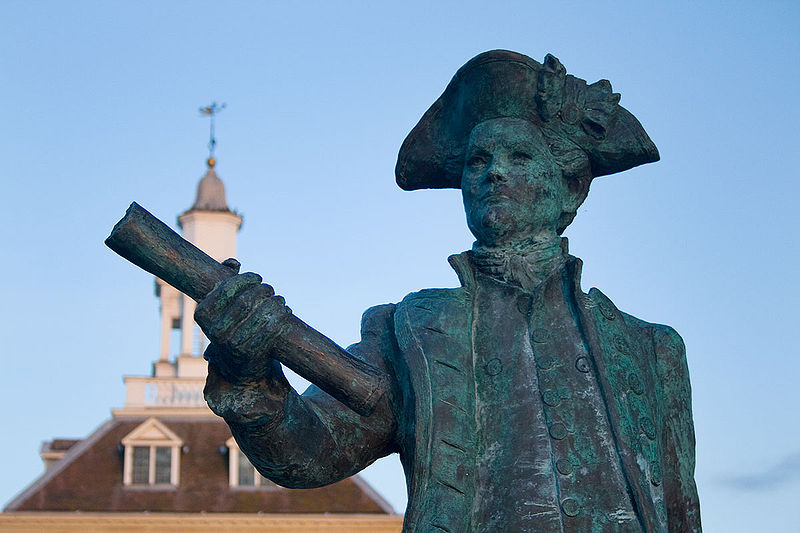<Back to Index>
- Mathematician Hermann Minkowski, 1864
- Poet Jacques Delille, 1738
- Royal Navy Captain George Vancouver, 1757
PAGE SPONSOR


Captain George Vancouver RN (June 22, 1757 – May 10, 1798) was an officer in the British Royal Navy, best known for his Vancouver Expedition maritime exploration of the North America's northwestern Pacific Coast regions, including the coasts of contemporary Alaska, British Columbia, Washington and Oregon. He also explored the Hawaiian Islands and the southwest coast of Australia.
Vancouver Island, Canada; the cities of Vancouver, British Columbia, Canada, and Vancouver, Washington, U.S.; and Mount Vancouver on the Yukon/Alaskan border; are named after him. Vancouver's first naval service was as a midshipman aboard HMS Resolution, on James Cook's second voyage (1772 – 1775) searching for Terra Australis. He also accompanied Cook's third voyage (1776 – 1778), this time aboard Resolution's sister ship, HMS Discovery and the first European sighting and exploration of the Hawaiian Islands. Upon his return to Britain in 1779, Vancouver was commissioned as a lieutenant and posted aboard the sloop HMS Martin surveying coastlines. In the late 1780s the Spanish commissioned an expedition to the Pacific Northwest. However, the 1789 Nootka Crisis intervened. Spain and Britain came close to war over ownership of the Nootka Sound on contemporary Vancouver Island, and of greater importance, the right to colonize and settle the Pacific Northwest coast. Roberts and Vancouver joined Britain's more warlike vessels. Vancouver went with Whidbey to the HMS Courageux. When the first Nootka Convention ended the crisis in 1790, Vancouver was given command of HMS Discovery to take possession of Nootka Sound and to survey the coasts. Departing
England with two ships in April, 1791, Vancouver commanded an
expedition charged with exploring the Pacific region. In its first year
the expedition travelled to Cape Town, Australia, New Zealand, Tahiti,
and China, collecting botanical samples and surveying coastlines along
the way. Proceeding to North America, Vancouver followed the coasts of
present day Oregon and Washington northward. In April 1792 he encountered American Captain Robert Gray off the coast of Oregon just prior to Gray's sailing up the Columbia River. Vancouver entered the Strait of Juan de Fuca, between Vancouver Island and the Washington state
mainland on April 29, 1792. His orders included a survey of every inlet
and outlet on the west coast of the mainland, all the way north to Alaska.
Most of this work was done from small boats powered by both oars and
sail because maneuvering larger sail-powered vessels in uncharted
waters was generally impractical and dangerous. Vancouver was the first European to enter Burrard Inlet on June 13, 1792, naming it after his friend Sir Harry Burrard. It is the present day main harbour area of the City of Vancouver beyond Stanley Park. He surveyed Howe Sound and Jervis Inlet over the next nine days. Then, on his 35th birthday on June 22, 1792, he returned to Point Grey, the present day location of the University of British Columbia. Here he unexpectedly met a Spanish expedition led by Dionisio Alcalá Galiano and Cayetano Valdés y Flores. Vancouver was "mortified" (his word) to learn they already had a crude chart of the Strait of Georgia based on the 1791 exploratory voyage of José María Narváez the year before, under command of Francisco de Eliza. For three weeks they cooperatively explored the Georgia Strait and the Discovery Islands area before sailing separately towards Nootka Sound. After the summer surveying season ended, in November 1792 Vancouver went to Nootka,
then the region's most important harbour, on contemporary Vancouver
Island. Here he was to receive any British buildings and lands returned
by the Spanish from claims by Francisco de Eliza for the Spanish crown. The Spanish commander, Juan Francisco Bodega y Quadra,
was very cordial and he and Vancouver exchanged the maps they had made,
but no agreement was reached; they decided to await further
instructions. At this time, they decided to name the large island on
which Nootka was now proven to be located as Quadra and Vancouver Island. Years later, as Spanish influence declined, the name was shortened to simply Vancouver Island. In October 1792, he sent Lieutenant William Robert Broughton with several boats up the Columbia River. Broughton got as far as the Columbia River Gorge, sighting and naming Mount Hood. Vancouver sailed south along the coast of Spanish Alta California, visiting Chumash villages at Point Conception and near Mission San Buenaventura. Vancouver spent the winter in continuing exploration of the Sandwich Islands, the contemporary islands of Hawaii. The next year, 1793, he returned to British Columbia and proceeded further north, unknowingly missing the overland explorer Alexander Mackenzie by
only 48 days. He got to 56°N, but because the more northern parts
had already been explored by Cook, he sailed south to Alta California,
hoping to find Bodega y Quadra and fulfill his territorial mission, but the Spaniard was not there. He again spent the winter in the Sandwich Islands. In 1794, he first went to Cook Inlet, the northernmost point of his exploration, and from there followed the coast south to Baranov Island, which he had visited the year before. He then set sail for Great Britain by way of Cape Horn, returning in September 1795, thus completing a circumnavigation. Vancouver faced difficulties when he returned home to England. The accomplished and politically well-connected naturalist Archibald Menzies complained that his servant had been pressed into service during a shipboard emergency; sailing master Joseph Whidbey had a competing claim for pay as expedition astronomer; and Thomas Pitt, 2nd Baron Camelford, whom Vancouver had disciplined for numerous infractions and eventually sent home in disgrace, challenged him to a duel. Vancouver was attacked in the newspapers and assaulted on the street by Pitt. His career was effectively at an end. Captain
George Vancouver, one of Britain's greatest explorers and navigators,
died in obscurity on May 10, 1798 at the age of 40, less than three
years after completing his voyages and expeditions. His modest grave
lies in St. Peters churchyard, Petersham, Surrey, in southern England. Vancouver determined that the Northwest Passage did
not exist at the latitudes that had long been suggested. His charts of
the North American northwest coast were so extremely accurate that they
served as the key reference for coastal navigation for generations. Robin Fisher, the academic Vice President of Mount Royal University in Calgary and author of two books on Vancouver, states: He
[Vancouver] put the northwest coast on the map... He drew up a map of
the north-west coast that was accurate to the 'nth degree,' to the
point it was still being used into the modern day as a navigational
aid. That's unusual for a map from that early a time. Vancouver, however, failed to discover two of the largest and most important rivers on the Pacific coast, the Fraser River and the Columbia River. He also missed the Skeena River near
Prince Rupert in northern British Columbia. Vancouver did eventually
learn of the river before he finished his survey — from Robert Gray, captain of the American merchant ship that was the first Euroamerican sailing of the Columbia River on
May 11, 1792, after first sighting it on an earlier voyage in 1788.
However it and the Fraser River never made it onto Vancouver's charts.
Stephen R. Bown, noted in Mercator's World magazine (November/December 1999) that: How
Vancouver could have missed these rivers while accurately charting
hundreds of comparatively insignificant inlets, islands, and streams is
hard to fathom. What is certain is that his failure to spot the
Columbia had great implications for the future political development of
the Pacific Northwest...." While
it is difficult to comprehend how Vancouver missed the Fraser River,
much of this river's delta was subject to flooding and summer freshet which prevented the captain from spotting any of its great channels as he sailed the entire shoreline from Point Roberts, Washington, to Point Grey in 1792. The Spanish expeditions to the Pacific Northwest, with the 1791 Francisco de Eliza expedition preceding Vancouver by a year, had also missed the Fraser River
although they knew from its muddy plume that there was a major river
located nearby. Vancouver generally established a good rapport with both Indigenous peoples and
European foreigners. Captain Vancouver played an undeniable role in the
subsequent series of upheavals and losses in the lives and homelands of
the Indigenous peoples of the Americas on the North American Pacific Coast, since his explorations opened up the region to European colonization and occupation. Serious negative impacts on the First Nations and Native American peoples,
and their cultures and territories resulted. However, historical records
show Vancouver himself enjoyed good relations with native leaders both
in Hawaii - where native leaders ceded Hawaii to Vancouver in 1794 - as
well as the Pacific Northwest and Alta California. Vancouver's journals exhibit a high degree of sensitivity to natives. He wrote of meeting the Chumash people, and of his exploration of a small island on the Alaskan coast
on which an important burial site was marked by a sepulchre of
"peculiar character" lined with boards and fragments of military
instruments lying near a square box covered with mats. Vancouver states: This
we naturally conjectured contained the remains of some person of
consequence, and it much excited the curiosity of some of our party;
but as further examination could not possibly have served any useful
purpose, and might have given umbrage and pain to the friends of the
deceased, should it be their custom to visit the repositories of their
dead, I did not think it right that it should be disturbed. Vancouver also displayed contempt in his journals towards unscrupulous western traders who provided guns to natives by writing: I
am extremely concerned to be compelled to state here, that many of the
traders from the civilised world have not only pursued a line of
conduct, diametrically opposite to the true principles of justice in
their commercial dealings, but have fomented discords, and stirred up
contentions, between the different tribes, in order to increase the
demand for these destructive engines... They have been likewise eager
to instruct the natives in the use of European arms of all
descriptions; and have shewn by their own example, that they consider
gain as the only object of pursuit; and whether this be acquired by
fair and honourable means, or otherwise, so long as the advantage is
secured, the manner how it is obtained seems to have been, with too
many of them, but a very secondary consideration. Robin
Fisher notes that Vancouver's "relationships with aboriginal groups
were generally peaceful; indeed, his detailed survey would not have
been possible if they had been hostile." While there were hostile incidents at the end of Vancouver's last season - the most serious of which involved a clash with Tlingits at Behm Canal in southeast Alaska in 1794 - these were the exceptions to Vancouver's exploration of the U.S. and Canadian Northwest coast. Despite
a long history of warfare between Britain and Spain, Vancouver
maintained excellent relations with his Spanish counterparts and even
feted a Spanish sea captain aboard the tall ship HMS Discovery during his 1792 trip to the Vancouver region. There
has been some debate about the origins of the Vancouver name. It is now
commonly accepted that the name Vancouver derives from the expression van Coevorden, meaning "(originating) from Coevorden", a city in the northeast of the Netherlands.
This city is apparently named after the "Coeverden" family of the 13 -
15th Century. An alternative theory claims that Vancouver is a misspelling or anglicized version of Van Couwen, a Dutch family name. In
the 16th century, a number of businessmen from the Coevorden area (and
the Netherlands in general) did move to England. Some of them were
known as Van Coeverden. Others adopted the surname Oxford, as in oxen crossing, which is approximately the English translation of Coevorden.
However this is not the exact name of the noble family mentioned in the
history books that claim Vancouver's noble lineage: that name was Coeverden not Coevorden. In the 1970s, Adrien Mansvelt, a former Consul General of
the Netherlands based in Vancouver, published a collation of
information in both historical and genealogical journals and in the Vancouver Sun newspaper. Mansvelt's theory was later presented by the city during the Expo 86 World's Fair, as historical fact. Mr. Mansvelt's theories, however, are based on many assumptions and possibilities that may be flawed. Genealogy is
the study or investigation of ancestry and family history, with
undeniable proof of traceability through family lineage of birth,
marriage and death records. Mansveld bases his research on no such
proof and uses the words "assumed", "possible" and "may" time and again
throughout his essay. This problematic information was then used as rock solid proof for Mr. W. Kaye Lamb to write his book A Voyage of Discovery to the North Pacific Ocean and Round the World, 1791 - 1795. W.
Kaye Lamb, in summarizing Mansvelt's unsubstantiated 1973 research,
suggests evidence of close family ties between the Vancouver family of
Britain and the Van Coeverden family of Holland as well as George
Vancouver's own words from his diaries in referring to his Dutch
ancestry: As
the name Vancouver suggests, the Vancouvers were of Dutch origin.
Popular theory suggests that they were descended from the titled van
Coeverden family, one of the oldest in the Netherlands. By the twelfth
century, and for many years thereafter, their castle at Coevorden, in the Province of Drenthe,
was an important fortress on the eastern frontier. George Vancouver was
aware of this. In July 1794, he named the Lynn Canal "after the place
of my nativity" and Point Couverden (which he spelt incorrectly) "after
the seat of my ancestors". Vancouver's great grandfather, Reint Wolter
van Couverden, was probably the first of the line to establish an
English connection. While serving as a squire at one of the German
courts he met Johanna (Jane) Lilingston, an English girl who was one of
the ladies in waiting. They were married in 1699. Their son, Lucas
Hendrik van Couverden, married Vancouver's grandmother, Sarah... In his
later years he probably anglicized
his name and spent most of his time in England. By the eighteenth
century, the estates of the van Couverdens were mostly in the Province
of Overijssel, and some of the family were living in Vollenhove, on the Zuider Zee.
The English and Dutch branches kept in touch, and in 1798 (the date of
Vancouver's death) George Vancouver's brother Charles would marry a
kinswoman, Louise Josephine van Couverden, of Vollenhove. Both were
great-grandchildren of Reint Wolter van Couverden." George Vancouver also identified a body of land off the Alaskan coast as 'Couverden Island' during his exploration of the North American Pacific coast presumably to honour his family's Dutch hometown of Coevorden. It is located at the western point of entry to Lynn Canal in southeastern Alaska.
